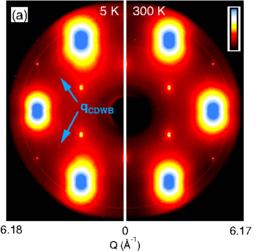Newly discovered material property may lead to high temp superconductivity

This image shows high-energy x-ray diffraction patterns of the reciprocal lattice plane (H?K?0). The CDW superstructure peaks are marked by blue arrows (logarithmic color scale). Credit: U.S. Department of Energy, Ames Laboratory
While studying purple bronze, a molybdenum oxide, researchers discovered an unconventional charge density wave on its surface.
A charge density wave (CDW) is a state of matter where electrons bunch together in a repeating pattern, like a standing wave of surface of water. Superconductivity and charge density waves share a common origin, often co-exist, and can compete for dominance in certain materials.
Conventional CDWs and superconductivity both arise from electron-phonon interactions, the interaction of electrons with the vibrations of the crystal lattice. Electron-electron interactions are the likely origin of unconventional, high-temperature superconductivity such as found in copper- and iron-based compounds.
Unconventional, electron-electron driven CDW are extremely rare and its discovery here is important, because the material showed an 'extraordinary' increase of CDW transition temperature from 130K (-143°C) to 220K (-53 °C) and a huge increase of energy gap at the surface.
Both are properties essential for CDW and high-temperature superconductivity, explained Adam Kaminski, Ames Laboratory scientist and professor in the Department of Physics and Astronomy at Iowa State University.
“This was an accidental but very exciting discovery,” said Kaminski. “We were studying this material because its one-dimensional structure makes it quite interesting. We saw strange things happening to the electronic band structure, but when we looked at the surface we were stunned by extraordinary enhancement of transition temperature and energy gap.”
###
The science is further discussed in the paper, “Discovery of an Unconventional Charge Density Wave at the Surface of K0.9Mo6O17”, co-authored by Daixiang Mou, A. Sapkota, H.-H. Kung, Viktor Krapivin, Yun Wu, A. Kreyssig, Xingjiang Zhou, A. I. Goldman, G. Blumberg, Rebecca Flint, and Adam Kaminski; and featured as an Editor's Suggestion in Physical Review Letters.
The research used resources of the Advanced Photon Source, a DOE Office of Science User Facility at Argonne National Laboratory.
Ames Laboratory is a U.S. Department of Energy Office of Science national laboratory operated by Iowa State University. Ames Laboratory creates innovative materials, technologies and energy solutions. We use our expertise, unique capabilities and interdisciplinary collaborations to solve global problems.
DOE's Office of Science is the single largest supporter of basic research in the physical sciences in the United States, and is working to address some of the most pressing challenges of our time. For more information, please visit science.energy.gov.
Media Contact
All latest news from the category: Materials Sciences
Materials management deals with the research, development, manufacturing and processing of raw and industrial materials. Key aspects here are biological and medical issues, which play an increasingly important role in this field.
innovations-report offers in-depth articles related to the development and application of materials and the structure and properties of new materials.
Newest articles

An Endless Loop: How Some Bacteria Evolve Along With the Seasons
The longest natural metagenome time series ever collected, with microbes, reveals a startling evolutionary pattern on repeat. A Microbial “Groundhog Year” in Lake Mendota Like Bill Murray in the movie…

Witness Groundbreaking Research on Achilles Tendon Recovery
Achilles tendon injuries are common but challenging to monitor during recovery due to the limitations of current imaging techniques. Researchers, led by Associate Professor Zeng Nan from the International Graduate…

Why Prevention Is Better Than Cure—A Novel Approach to Infectious Disease Outbreaks
Researchers have come up with a new way to identify more infectious variants of viruses or bacteria that start spreading in humans – including those causing flu, COVID, whooping cough…



